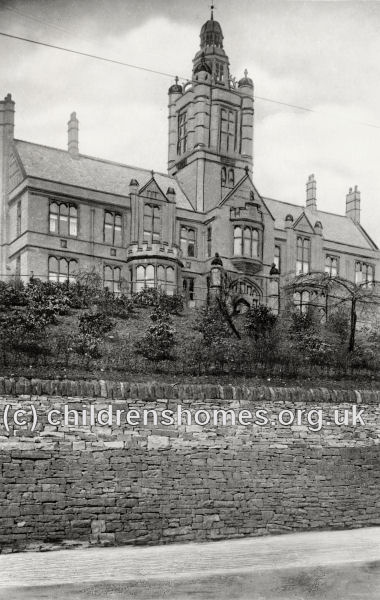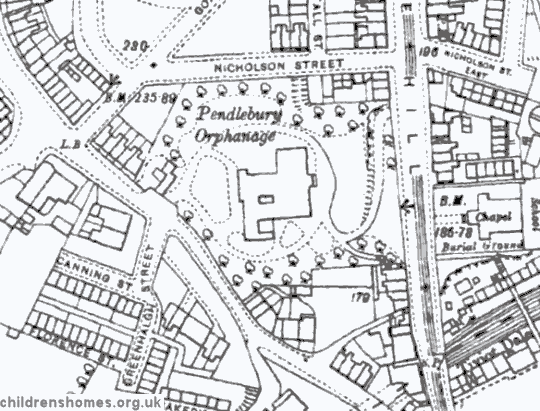Sir Ralph Pendlebury Orphanage, Stockport, Cheshire
Sir Ralph Pendlebury Orphanage was established in 1882 as a result of a legacy of £100,000 by the former Mayor of Stockport and mill owner. Pendlebury died on 9th November 1861 and it took more than twenty years for his legatees to settle on the Orphanage scheme, although prior to that, a charity set up to administer the funds had dispensed money to other good causes.
The new building was erected on a plot of land on Lancashire Hill, Heaton Norris, opposite Hanover Independent Chapel. Five architects submitted plans for the establishment, with the selected design being by Mr J.W. Beaumont of Manchester and Wilmslow. Its construction cost in the region of £10,000, exclusive of furnishing.
The Orphanage was formally opened on April 13th, 1882, the ceremony being performed by Lord Vernon. The building had three linked sections One portion occupied by the main house, the second by administrative offices for outdoor relief, and the third by the principal entrance and an assembly hall. The house included a day room, 30 feet by 20 feet, with separate entrances and cloak rooms for boys and girls, a large kitchen, offices, and two parlours for the master and mistress. On the first floor were two large dormitories and four smaller bedrooms, bathroom, linen closet, etc. The outdoor relief department comprised a boardroom, ladies' committee-room, secretary's office, cloakrooms, and applicants' waiting-room with separate entrance. The buildings were faced with Ruabon red stock bricks, with stone jambs and mullions to the windows and doors and moulded strings of stone and terracotta. A tower at the centre of the building rose to a height of 98 feet from which distant views could be obtained. The building contractors were Messrs. Southern and Sons of Stockport.

Pendlebury Orphanage, Stockport, from the south-east, early 1900s. © Peter Higginbotham
The Orphanage's regulations stated that the institution was intended to benefit 'indigent orphans who, or whose parent or parents, have, or has been resident for not leas than two years in the borough, parishes or townships of Stockport, Heaton Norris, Reddish, Brinnington, Bredbury, Romiley. Offerton, Norbury, Bramhall, Cheadle, Cheadle Moseley, Cheadle Bulkeley, Cheadle Hulme, Stockport Etchells, or Burnage, all in the counties of Chester or Lancaster.' Furthermore, 'no child born out of wedlock, or who, or either of whose parents have been in receipt of parish relief within two years before the date of application, will be eligible for the benefits of the charity, except under special circumstances.' The instruction to be given in the Orphanage was to be 'moral, religious, and unalterably based upon Protestant principles, such as are commonly held by believers in the Divinity of our Lord Jesus Christ, but so nevertheless that no denominational teaching or catechism whatever shall be introduced or form part of the instruction.'
The Orphanage site is shown on the 1910 map below.

Sir Ralph Pendlebury Orphanage site, Stockport, c.1910.
During the First World War, the premises were loaned to the Stockport Division of the Red Cross Society for use as a military hospital. By the 1950s, the site was occupied by the Stockport Secondary Technical School for Boys. It later became Pendlebury Hall residential care home, now known as Hilltop Hall.
Sir Ralph Pendlebury's Charity for Orphans is still in operation and provides grants to the parents or guardians of orphaned children in the Stockport area who are judged worthy of financial support.
Records
Note: many repositories impose a closure period of up to 100 years for records identifying individuals. Before travelling a long distance, always check that the records you want to consult will be available.
- Stockport Archives, Central Library, Wellington Road South, Stockport SK1 3RS. Holdings: Records for Sir Ralph Pendlebury's Charity for Orphans (1870-1980); Ground plan of the orphanage.
Bibliography
- Higginbotham, Peter Children's Homes: A History of Institutional Care for Britain s Young (2017, Pen & Sword)
Links
- None identified at present.
Except where indicated, this page () © Peter Higginbotham. Contents may not be reproduced without permission.


